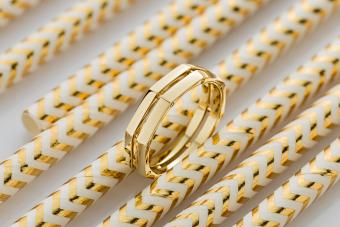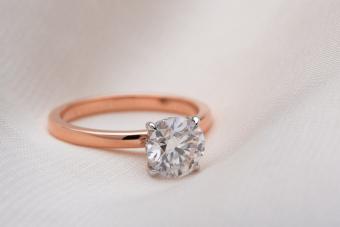
Your grandma's yellow gold engagement ring has plenty of warmth and charm, but it's not the only option. In fact, when it comes to wearing or buying gold jewelry, there are actually several different colors of gold to choose from. We're talking everything from a classic cool white to moody black.
You've got more choices than ever before. Choosing gold jewelry in different colors allows you to have fun with your jewelry and experiment with mixing colors of gold to match your own personal style.
A Rainbow of Shades of Gold Jewelry
Gold jewelry comes in a wide range of hues from classic colors such as yellow to bold colors such as purple, but get this: the secret to the color variation is the metals that the gold is mixed with. Pure gold, or 24-karat gold, is yellow, but when you mix it with other metals, you get all kinds of shades.
Yellow Gold

Pure gold in its natural state is the color yellow, and all 24-karat gold is yellow. But that doesn't mean all yellow gold is 24-karat (for one thing 24-karat gold is super soft and isn't always practical). Yellow gold is often alloyed with a metal such as silver or copper to add strength to the overall piece. The higher the karat of yellow gold, the deeper the color of yellow.
Yellow gold is used for a variety of items from simple stud earrings to fashionable necklaces and bracelets. You'll often see it in rings and settings as well.
Although there are lots of uses for gold, including electronics and dentistry, jewelry is still the most common thing gold is used for. 49% of the world's gold ends up in jewelry.
White Gold

White gold is gold mixed with silver, nickel, palladium, platinum, or zinc in order to get the white hue. 18-karat white gold is about 75% gold and 25% other metals, although it can be less gold for a lower karat. White started as an imitation of platinum, but now people love it for itself. Some white gold is also plated with a metal such as rhodium to get a richer and shinier white color.
You can find rings, necklaces, bracelets, and earrings in white gold. White gold tends to sell at a similar price to yellow gold of the same karat. There's no such thing as 24-karat white gold, but you can find 18-karat.
Because white gold sometimes contains some nickel, those with an allergy to nickel may be sensitive to wearing white gold. If you're concerned, ask about the specific alloy used to make the white gold.
Rose Gold

Like white gold, rose gold is made by mixing pure gold with other metals. In this case, 18-karat rose gold a mixture of about 75% gold and 25% copper and silver. Rose gold, also sometimes called pink or blush gold, gets its pretty pink tint from the copper. The more copper used will produce a redder hue of gold while less copper will produce a pinker color.
Many types of jewelry are available in rose gold, including everything from earrings to necklaces. Pricing is similar to yellow and white gold, when you compare similar karats.
Some jewelers offer "red gold," which is rose gold with a lot more copper in it and less pure gold. This deep shade can be really pretty.
Green Gold

Green gold is made by adding silver to gold. This type of gold does not contain copper. Green gold is more unusual than most other colors and is often used as a detail in a larger design. For example, Black Hills Gold uses green gold for leaves and accents in their designs. You can also green gold wedding bands and rings.
Green gold isn't sold that often on its own, but it tends to sell for a similar price to white gold.
Green gold is also known as electrum, and it can occur naturally. The amount of gold and silver can vary in natural electrum, so the color can vary too.
Black Gold

Black gold is gold coated with a layer of ruthenium for added strength. A black or brownish color can also be achieved by treating gold alloyed with copper with potassium sulfide.
You actually don't encounter a lot of black gold jewelry, but it's sometimes used for wedding rings or statement pieces. Black gold varies in price. Even though the amount of actual gold is less than in yellow gold, it's often just as expensive because of the process required to make it.
Related: 5 Tips for Wearing Gold Jewelry
Purple Gold or Violet Gold

Some purple gold is created by mixing gold with aluminum and indium, and other types of violet or purple gold are made by adding a colored ceramic rhodium coating to white gold. Either way, this is a striking shade of gold jewelry, and you'll see some very intricate pieces.
While purple gold has not quite yet made its way into most jewelry stores and boutiques and is even still pretty rare online, you can find it in specialty stores. It tends to be more expensive than its karat in yellow gold, due to the processing it requires to make.
If you know someone who loves the color purple, violet gold looks amazing with an amethyst gem.
Blue Gold

Another super funky and different color of gold is blue. Blue gold comes from mixing gold with iron, gallium, or indium. Some are also made by plating white gold with blue-toned coatings. Either way, it's very rare and really cool looking.
You may see blue gold wedding rings, and some specialty jewelers make blue gold engagement sets. These tend to be more expensive than their yellow gold counterparts because of the work involved in making the color of gold.
Grey Gold

Made by mixing gold with manganese, silver, or iron (or some combination of these), grey gold has a cool, sleek look that can be pretty amazing in a wedding band or engagement ring. You don't often see it used for other types of jewelry, but it could be lovely.
It costs about the same as other fancy gold shades, which means it's a little more expensive than yellow gold of a similar karat.
Value of Colored Gold
No matter what shade of gold jewelry you're talking about, it's sure to be valuable. That's because the amount of gold found in an item is priced the same regardless of color. Often, colored gold is just as valuable as yellow or white gold. In some cases, it can be more valuable because of how difficult it is to produce.
Generally, gold is valued based on weight. The value of gold is constantly changing, so to determine a value, you will want to check a gold market report to get a daily quote.
Explore All the Gold Colors
Yellow is lovely, but different colors of gold can also be beautiful. Whether you're looking for something unique like purple or want a different take on a classic like rose gold, it's all gorgeous. Exploring all the gold colors lets you know your options and choose the best one for you.







